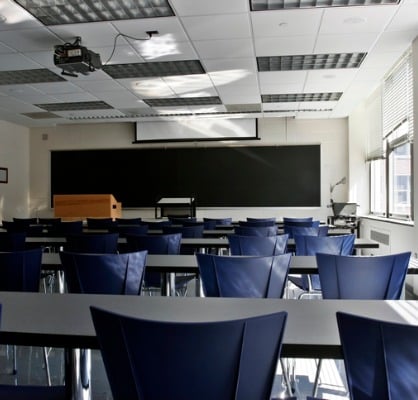
Classroom Cleaning for Infectious Disease Control
Given the CDC’s recommendation of everyday disinfecting of frequently touched surfaces, now more than ever it’s critical to have the right classroom cleaning tools to optimize the efficiency and effectiveness of disinfesting processes. Procuring the highest quality cleaning tools for classrooms, in addition to gyms, restrooms, buses and common spaces, can help prevent the spread of infectious diseases to staff, students, volunteers and community members.
The Difference Between Cleaning and Disinfecting
Effective cleaning processes are the first line of defense in removing dirt, germs and impurities from high touch surfaces. By removing classroom germs prior to the subsequent disinfecting process, you lower the magnitude of germs and ultimately, reduce the overall risk of spreading infection in your facility. Only through disinfecting can you kill the remaining germs that cleaning leaves behind. Disinfecting works by using chemicals, but it doesn’t necessarily clean surfaces or remove germs, making it a necessity to use the right tools for cleaning high touch areas in the classroom prior to disinfection.
Cleaning High Touch Surfaces in the Classroom
A school’s standard procedure for routine cleaning and disinfecting of classrooms typically includes addressing high touch surfaces and objects, such as desks, chairs, counters, doorknobs and handles, computer keyboards, etc. Combined with cleaning larger areas and surfaces (classroom floors, common spaces and bathrooms), having the right equipment to clean faster, safer and cleaner is critical to keeping educational facilities as healthy as possible.
Here are the recommended features to look for when sourcing classroom cleaning solutions that fight against the spread of infectious disease:
Microfiber Cleaning Technology
Microfiber is made up of thousands of tiny strands that are each 10-50 times smaller than the diameter of human hair. When woven together these strands create a surface area covered with millions of spaces between the fibers to trap moisture, dirt and debris, making it a superior cleaning technology to other materials on the market. When it comes to cleaning classroom desks and tables, by using a microfiber pad or cloth, you can expect to reduce 96% of surface bacteria with less chemicals.
Certain desk and table cleaning tools that utilize microfiber technology can also clean 4X faster, enabling more desk and table cleanings per day. But the power of microfiber doesn’t stop at tabletop surfaces, you can further reduce surface bacteria and dirt when using microfiber as part of your indoor window cleaning system and floor cleaning solutions. These systems, such as the Unger Stingray window cleaning kit, have the added benefit of touch free cleaning, keeping custodial staff’s hands safely away from direct contact with surface contaminants thanks to the system’s telescopic pole that holds the microfiber pad.
Color-Coded Cleaning Tools that Minimize Cross Contamination
Color coded cleaning systems are designed to designate specific cleaning zones within a facility. This type of system allows facility managers and cleaning staff to organize equipment and prevent cross-contamination between work zones (example: using restroom cleaning mops in restroom areas only, floor cleaning mops in classroom spaces).
Distinct color-coding makes it easy to separate tools into their correct areas of use or cleaning task, reducing bacteria and cross-contamination between high and low-risk areas. Using a combination of color-coded microfiber cloths and microfiber mops result in better sanitation facility-wide and cleaner classrooms specifically.
Dual Buckets that Keep Cleaning Water, Clean
When mopping classroom and restroom floors, dual-compartment buckets separate clean water from dirty solution, ensuring the use of clean solution with every stroke of the mop. By isolating dirt and maximizing usage of the cleaning solution, the result is a highly efficient cleaning process that makes a significant impact on cross contamination prevention efforts and also saves time and money.
More Than Ever, You Must Truly Clean Classrooms with The Right Tools
During these challenging times, it’s important that everyone stay safe and clean wherever you can to reduce the spread of Coronavirus and other infectious diseases. As your own facility takes the necessary steps to ensure the safety of your property, staff and students, the guidelines to which commercial cleaning tools and technologies we recommend will help you achieve the best level of results for your educational facility.
Learn More about Products and Processes for Infection Control Cleaning >
